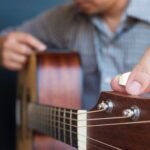Guitar repairs can be start with some basic knowledge and the right tools. Guitar repairs can start by identifying the issue, whether it’s a warped neck or a faulty truss rod, and replace the neck if necessary. Next, replace tuners and the nut, ensuring proper fit and height adjustments. Redress frets by sanding down high ones, and repair any stripped bolt-on neck holes using wood glue and toothpicks. For body repairs, fix broken wings, loose strap buttons, or damaged bridge holes with careful gluing and re-threading. Electronics can be restored by re-soldering pickups, cleaning or replacing switches, potentiometers, and jacks with appropriate solvents or new parts. Finally, maintain hardware by cleaning or replacing bridges, pickup rings, knobs, and switch covers. Following these steps will restore your guitar’s playability and sound quality.
Guitar Repairs List:
Part 1: Neck and Headstock of Guitar Repairs:

- Identify the Problem: Diagnose the issue with the neck. If it’s a warped neck or truss rod issue, consider replacing the neck entirely, either with a new one or from a donor guitar with a damaged body.
- Replace the Tuners: Choose the tuners that suit your guitar’s style. For example, Les Paul-style headstocks use a 3×3 setup, while Stratocaster-style headstocks typically use 6-in-line tuners. Ensure you match the orientation if you’re replacing tuners with a different setup.
- Replace the Nut: If the nut is cracked or damaged, replace it. If possible, use a blank nut and cut it to the correct height, ensuring the slots are cut precisely. If removing a damaged nut, carefully cut the finish holding it in place and tap it out gently with a screwdriver and hammer. Install the new nut with wood glue and water (50/50 mix).

- Redress the Frets: Mark high frets with a permanent marker, and sand them down using a 120-grit sanding block. If the markers come off early, it’s a high fret; if not, it’s a low fret. Use files for fine adjustments to the fret ends.
- Guitar Repairs Bolt-On Holes: If the screw holes in the neck are stripped, fill the holes with glued toothpicks or wood scraps. After drying, re-thread the holes and screw the bolts back in.
Part 2: Body of guitar Repairs

- Guitar Repairs Body Wings: If the wings of the body are cracked, such as from a drop, glue them carefully. Ensure the glue bond is strong and secure, especially for smaller bodies like a Les Paul Junior.
- Guitar Repairs Strap Buttons: If the strap buttons have come loose, repair them by filling the holes (using the method mentioned for bolt-on neck holes), but avoid over-tightening.

- Guitar Repairs Bridge Holes: If the Tune-O-Matic or stop-bar holes have been stripped, follow the same procedure used for repairing strap buttons.
- Guitar Repairs the Neck Joint: If the neck joint has broken at the sides, carefully glue the area. If the bottom where the screws bolt in is damaged, repair or replace the body.
Part 3: Electronics of Guitar Repairs

- Guitar Repairs Pickups: If a pickup is malfunctioning, you can try re-soldering the coil wire. For further restoration, re-magnetize the coil magnets with strong earth magnets.
- Clean or Replace Switches: Use contact cleaner to clean the switches. To replace, disorder the old switch and solder in a new one, making sure the wiring matches the original.
- Clean or Replace Potentiometers (Pots): Spray contact cleaner into the pot to clean it. If replacement is needed, find a compatible pot (usually 50k ohms), then disorder the old one and solder in the new one.
- Clean or Replace Jacks: Clean the jack using contact cleaner, or replace the jack if it’s faulty. Solder the new jack into place carefully.
Part 4: Hardware Restoration of Guitar Repairs:

- Clean the Bridge: Clean plated or painted bridges with a microfiber cloth and water. For non-plated metal, use fine steel wool to restore its shine.
- Replace Pickup Rings and Restore Covers: Replace broken pickup rings with the correct size and color. For metal pickup covers, clean them carefully without damaging the surface.
- Replace or Repair Knobs: If knobs are damaged, tape around the pot’s shaft to fit the knob. If this doesn’t work, replace the knobs with new ones.
- Replace Switch and Jack Covers: If the switch cover is damaged, replace it. Clean or replace metal jack plates as needed, ensuring all screws and nuts are securely fastened.
Watch Video for Guitar Repairs
Conclusion:
Guitar repairs, while requiring attention to detail and patience, can significantly extend the life and performance of your instrument. By carefully diagnosing issues with the neck, body, electronics, and hardware, you can restore your guitar to its original condition or even improve its playability and sound. Whether you’re replacing tuners, fixing frets, or cleaning the electronics, each step contributes to enhancing the overall functionality of your guitar. With practice and the right tools, you’ll not only be able to fix problems but also develop a deeper understanding and appreciation for your instrument, keeping it in top shape for years to come.



